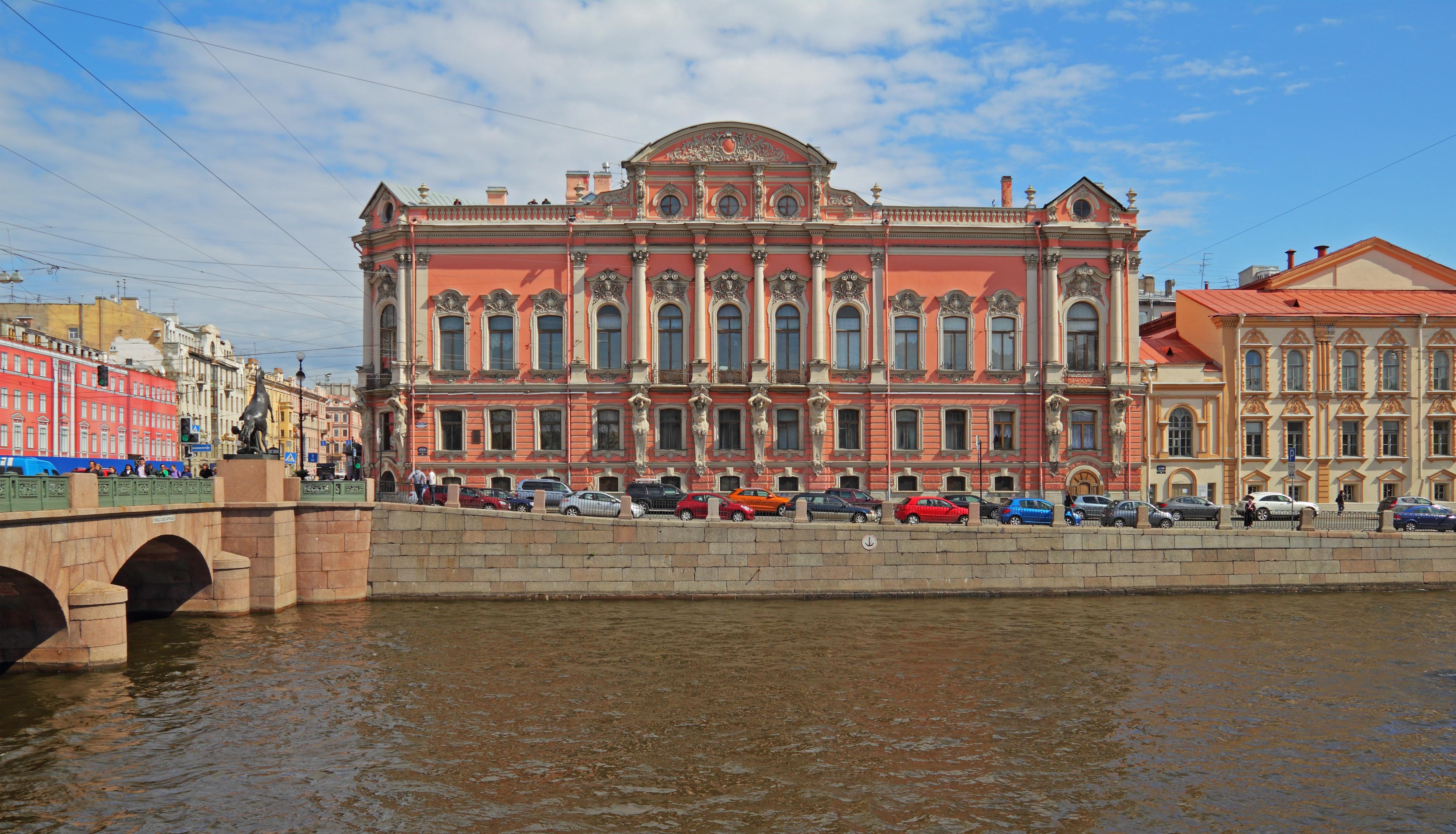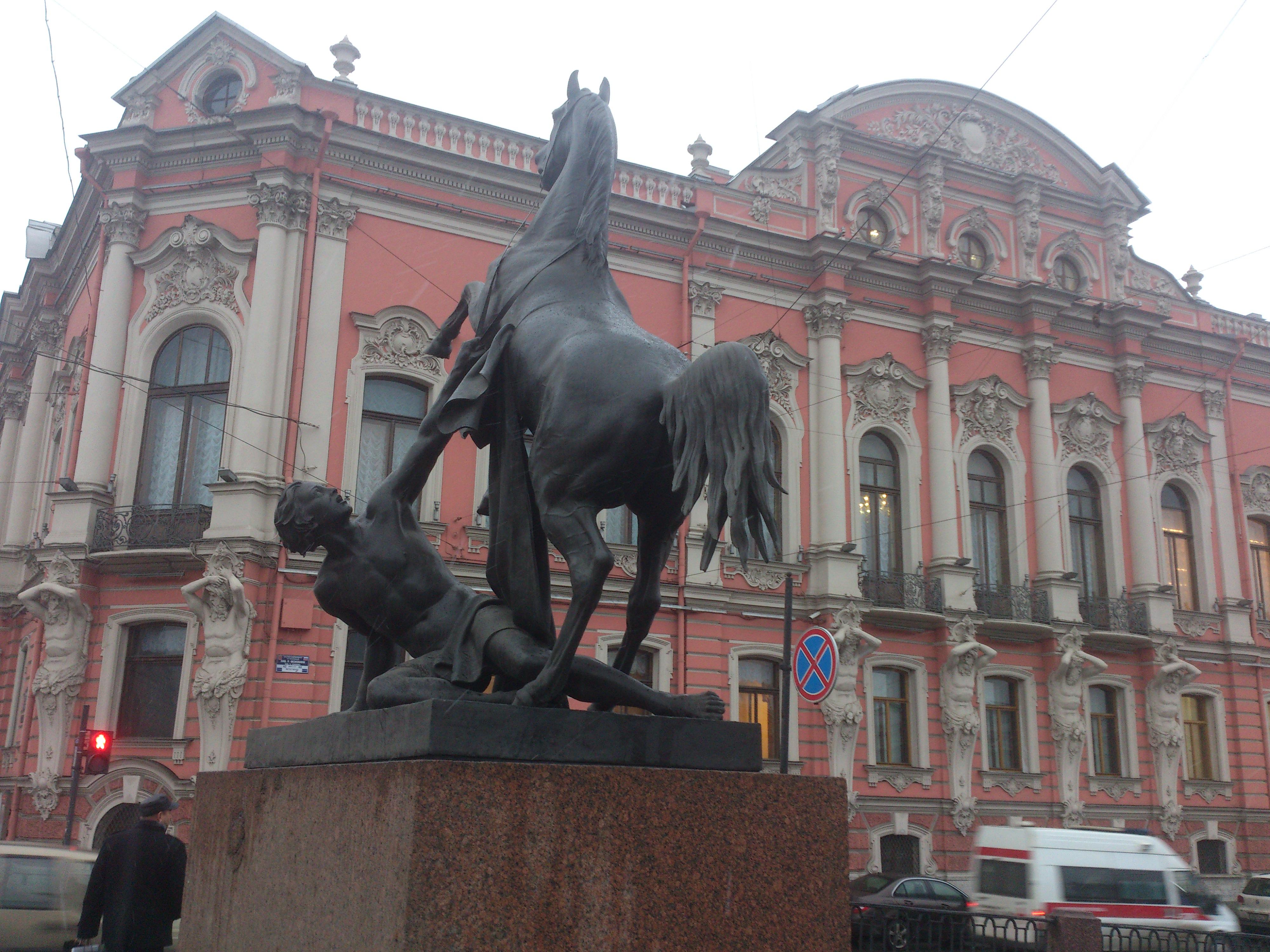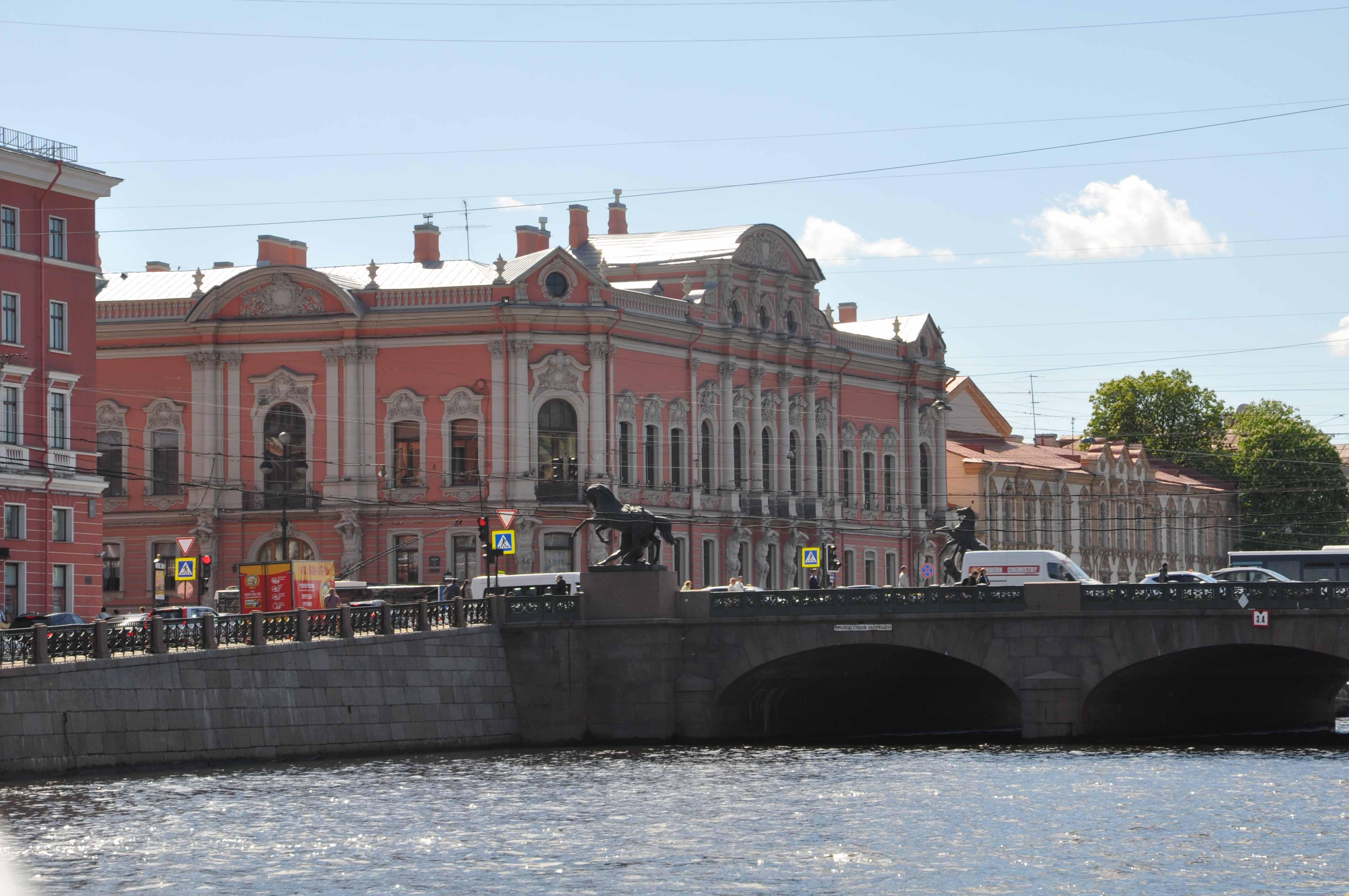Beloselsky-Belozersky Palace [Saint-Petersburg]
Beloselsky-Belozersky Palace/Дворец Белосельских-Белозерских
Описание
This dark-red was known as one of the most lavish palaces in Imperial Russia and also as being the venue of the most lavish balls and concerts in St. Petersburg.
The Beloselsky-Belozersky Palace is a Neo-Baroque palace designed by Andrey Stakenschneider at the intersection of the Fontanka River and Nevsky Prospekt. This dark-red is known as one of the most lavish palaces in Russia and also as being the venue of the most lavish balls and concerts in St. Petersburg.
A Baroque Masterpiece
Visitors were particularly impressed with the staircase and considered it to be the most beautiful of any of the private palaces of St. Petersburg.
The exterior reminds one of the Baroque Stroganov Palace, but lacks the inner movement of Rastrellis palace. Stakenschneiders creation has no inner energy. It is calm and austere. Yet the two palaces standing on the banks of two rivers provide an interesting architectural frame.
In 1797, Princess A. G. Beloselsky purchased from Naryshkin a small stone house on the corner of Nevsky Prospekt and the Fontanka. That house was demolished and in its place at the end of the XVIII century the architects Jean Thomas de Thomon and Fedor Demertsov built a three-storey palace with the modest facade in classical style.
Have a century later, Prince Constantine Esperovich Beloselsky-Belozersky commissioned the architect Andrei Stackenschneider to rebuild the palace. The palace was completely redone and acquired a modern look in 1847-1848. It is believed that Rastrelli’s Stroganov Palace was the model prototype for the Beloselsky-Belozersky Palace.
The new palace was done in the style of the so-called new Baroque and began to resemble the style of Rastrelli. As part of this work, Stackenschneider erected a new wing in the courtyard. He also recreated not only the exterior, but also the interior of the building. The facades of the palace were designed in the artistic techniques of Russian Baroque XVIII century.
A Denmark-born Russian sculptor David I. Jensen was invited to work on the interior decoration. David Ivanovich was the founder of Russia's first workshop for the production of sculpture and decorative ornaments from highly durable terracotta facades and interiors of buildings. Among his works: caryatids and bas-reliefs in the interior of the Mariinsky Palace. The atlantes and caryatids on the facades of the Beloselsky-Belozersky Palace were created based in his design.
Interior decoration of the palace was completed by Shtakenshneider. The grand staircase and marble fireplaces are his signature works. Along the stairs stood caryatids and sculptures supporting gilt candelabra, and the openwork lattice railing featured elegant monogram initials of the owner.
The library of Beloselsky-Belozersky was superbly decorated: the walls were covered with carved wooden panels and tight silk, decorated with a relief pattern fireplace, huge mirror in a gilded frame.
Constantine Esperovich Beloselsky-Belozersky did not live to see his palace – he died when the foundation was still being laid. His wife, or rather widow Elena Pavlovna (née Bibikova) married Vasily Kotchubey and moved into his house on Foundry Avenue. But she did not abandon the palace on Nevsky. It was there that she organized evening balls and social meetings. The Palace was located next to the Imperial Anichkov Palace and members of the royal family were frequent guests.
In 1865, Konstantin Beloselsky, the son of Elena Pavlovna, married Nadezhda Dmitrievna (née Skobeleva). The newlyweds settled in the palace on the Nevsky.
At the end of the XIX century the palace was owned by Esper A. Beloselsky-Belozersky. His wife, Princess Elena Pavlovna, was the chief Hofmeister at the court of the Empress, and as such popular with women seeking an audience with the empress. The Princess loved to throw grandiose balls. The Emperor Alexander III himself and his wife Maria Feodorovna were happy to come, but going home together was a different story. The empress was an avid dancer and loved to dance until dawn. In order to go home earlier than dawn, Alexander III, who instead of dancing spent him time playing whist or having casual conversations, would ask his aide, under various pretexts, to call musicians from the orchestra. Finally, the last musician standing would get up from his seat and wave his hands signaling that he can’t play alone – at that time the emperor would come to pick up his wife to go home. And once a year it was time for the grand court ball, with invitations sent out to some three thousand people.
The Palace at that time was in the most fashionable part of the capital. But then the crisis struck. This directly affected the owners. Capitalization of the metallurgical enterprises of the Urals - the main assets of the host - rapidly declined. There were many reasons, including the failure of management, and lack of investment in primary production. Prince Kotchubey tried to rectify the situation, even took loans from the state, but could not save the situation, and in the end had to sell the palace to the State Treasury to settle his debts.
In 1884, Tsar Alexander III gave the palace to his younger brother Sergey. It was a wedding gift for the marriage of the Grand Duke with Elizabeth Feodorovna (Princess Elisabeth of Hesse and by Rhine). The palace got a new name - St. Sergius. But that new name didn’t stick.
Источник информации: Saint-petersburg.guide
Адрес: Nevskiy Prospekt, 41, St. Petersburg, Russia
Телефон(ы): 8 (812) 312-36-44
Купить билеты
Достопримечательности рядом
Отзывы на ««Beloselsky-Belozersky Palace»» (Saint-Petersburg)
Общий рейтинг Гугл (4.7, всего отзывов: 1271). Ниже приведено несколько последних отзывов, полученных от Гугла.
Ходили туда в театр на несколько спектаклей. Небольшая группа актеров, сцена не меняется. (одни и те же декорации) Есть туалеты, гардероб в который нужно будет отстоять большую очередь. 2 больших зала и само помещение. Сама сцена находится на 2 этаже, места хватит человек на 350. Есть небольшие минусы. С рюкзаками не пускают (но на то это и театр), в низу звонков не слышно и самый главный то что в зрительном зале нет подъемов. Актеры говорят без микрофонов, когда сидели на 10 ряду все было слышно. Сам зал небольшой разделён на 2 части (правую и левую), второго этажа нет. Ну а в целом все понравилось, поэтому ставим 5 звёздочек!!
Красивый дворец! А вот сцену видно только с первых рядов. Места не возвышаются от сцены и с 5 ряда остаётся только слушать, а не смотреть что на сцене. Это огромный минус залу во Дворце. Жаль, что не думают о зрителях продавая билеты на разные постановки.
Очень красивый дворец, мне понравилось всё! Экскурсовод провела по дворцу всё подробно и грамотно рассказала, было очень интересно слушать. Потрясающие интерьеры. Уверен здесь должен побывать каждый!
Невероятно красивый дворец. Внутри чувствуешь всю прелесть и роскошь, которая господствовала в 19 веке. В каждой детали история. В первой мировой войне дом служил госпиталем. Под руководством британского доктора Флемминга. Переходил из одних рук в другие, но всегда оставался местом для баллов и светских мероприятий. Сейчас в здании сидит 1 канал, Санкт- Петербургский культурный центр, музей становления демократии в современной России имени Анатолия Собчака, Санкт-Петербургский государственный академический симфонический оркестр! Очень рекомендую посетить это чудо!
Сходили на ёлку во Дворце 30 декабря 2019 года. Шикарные костюмы и танцы, постановка ничего, немного было сложно с организационными вопросами -- билеты были без мест, и некоторые взрослые сели впереди, загородив обзор многим детям или вообще лишив их места, организаторам пришлось упрашивать на повышенных тонах их пересесть, некоторые не соглашались. Билеты были по 600 рублей, а я подарком за 1400. Сам подарок явно на 800 рублей не тянул -- просто набор сладких конфет, шоколада и мармелада. Можно было бы положить что-то более полезное для здоровья.
Что посмотреть in Saint-Petersburg
Дворцы, замки, усадьбы, дома
- Admiralty building
- Alexander Palace
- Anichkov Palace
- Beloselsky-Belozersky Palace
- Catherine Palace
- Constantine Palace
- Cottage Palace
- Derzhavin Estate Museum
- Gatchina Palace
- Marble Palace
- Mariinsky Palace
- Menshikov Palace
- Menshikov's Great Palace
- Mikhailovsky Castle
- Pavlovsk Palace
- Peterhof Grand Palace
- Shlisselburg (Oreshek) Fortress
- Stroganov Palace
- Summer Palace of Peter the Great
- Tauride Palace
- Vorontsov Palace
- Yelagin Palace
- Yusupov Palace
- Zinger Company House
Исторические места
Мосты
- Anichkov Bridge
- Bank Bridge
- Blue Bridge
- Bolsheokhtinsky Bridge
- Bridge of Four Lions
- Egyptian Bridge
- Potseluev Bridge
- Stone Bridge
Музеи
- A.S. Popov Central Museum of Communications
- Alexander Blok Apartment Museum
- Anna Akhmatova Literary and Memorial Museum
- Arkhip Kuindzhi's Apartment Museum
- Central Naval Museum
- Chaliapin House Museum
- Dostoevsky Museum
- Erarta
- Fabergé Museum
- Freud Museum of Dreams
- Grand Maket Rossiya
- Icebreaker Krasin
- Kunstkamera
- LabyrinthUm Museum
- Loft Project Floors Exhibition Hall
- Microminiature museum
- Military Historical Museum of Artillery, Engineers and Signal Corps
- Museum of Political History of Russia
- Narodovolets D-2 Submarine Museum
- Nekrasov Memorial Museum-Apartment
- Penates, I. Y. Repin's Estate Museum
- Peter I House
- Peter the Great Botanical Garden
- Petrovskaya Aquatoria, Scale Model
- Pushkin Museum and Memorial Apartment
- Rimsky-Korsakov Apartment and Museum
- Russian Museum
- Russian State Museum of Arctic and Antarctic
- Russian Vodka Museum
- Saint Isaac's Cathedral
- St. Petersburg State Museum of Theatrical and Musical Art
- State Hermitage Museum and Winter Palace
- State Memorial Museum of Leningrad Defense and Blockade
- Suvorov Museum
- The Museum of Lomonosov
- The Pushkin Country House Museum
- The State Museum of the History of St. Petersburg
- Tsarskoye Selo Lyceum
- Vladimir Nabokov Museum
- Vselennaya Vody Museum Complex
- Zoological Museum of the Zoological Institute of the Russian Academy of Sciences
Ночная жизнь, рестораны, кабаре
- Biblioteka
- Buddha-Bar
- Cafe Singer
- Club A2
- Coyote Ugly
- Gosti
- JFC Jazz Club
- Leningrad Center
- Makaronniki
- Old customs
- Retro Disco Club Papanin
- Terrassa
Памятники, скульптуры, статуи
- Bronze Horseman
- Egiptian Gates
- Monument to Nicholas I
- Monument to the Heroic Defenders of Leningrad
- Monument to the Nose of Major Kovalev
- Quay with Sphinxes
- Statue of Chizhik-Pyzhik
- The monument to Catherine II
Парки и природные достопримечательности
- Alexandrovsky Park
- Kirov Central Park of Culture and Recreation
- Leningrad Zoo
- Michael Garden
- Moskovsky Victory Park
- Peterhof. Lower park
- Summer Garden
- Tauride Garden
- The Park of the 300th anniversary
Площади, улицы, фонтаны, районы
Пляжи, аквапарки, купальни, бани, аквариумы
Спортивные сооружения
Театры и концертные залы
- Academical Maly Drama Theatre - Europe Theatre
- Akimov Comedy Theatre
- Alexandrinsky Theatre
- Hermitage Theatre
- Mariinsky Theatre
- Mikhaylovsky Theatre
- Saint Petersburg Philharmonia
- St. Petersburg Youth Theater on Fontanka
- Tovstonogov Bolshoi Drama Theater
Храмы, соборы, монастыри
- Alexander Nevsky Lavra
- Buddhist Temple
- Cathedral of Saints Peter and Paul
- Chapel of St. Xenia of St. Petersburg
- Church of the Savior on Blood
- Feodorovsky Cathedral
- Gothic Chapel
- Grand Choral Synagogue
- Kazan Cathedral
- Kronstadt Naval Cathedral
- Lutheran Church of St. Peter
- Peter and Paul Fortress
- Saint Petersburg Mosque
- Smolny Cathedral
- Sophia Cathedral
- Trinity Cathedral
- Vladimirskaya Church
Активный отдых, аттракционы, развлечения
- Bolshoi St Petersburg State Circus
- Divo Ostrov
- Dolphinarium
- Ice Palace
- Kidburg
- Piterland Aquapark
- Planetarium
Прочее
В списке обозначено:
- Топ-достопримечательности
- Для детей


